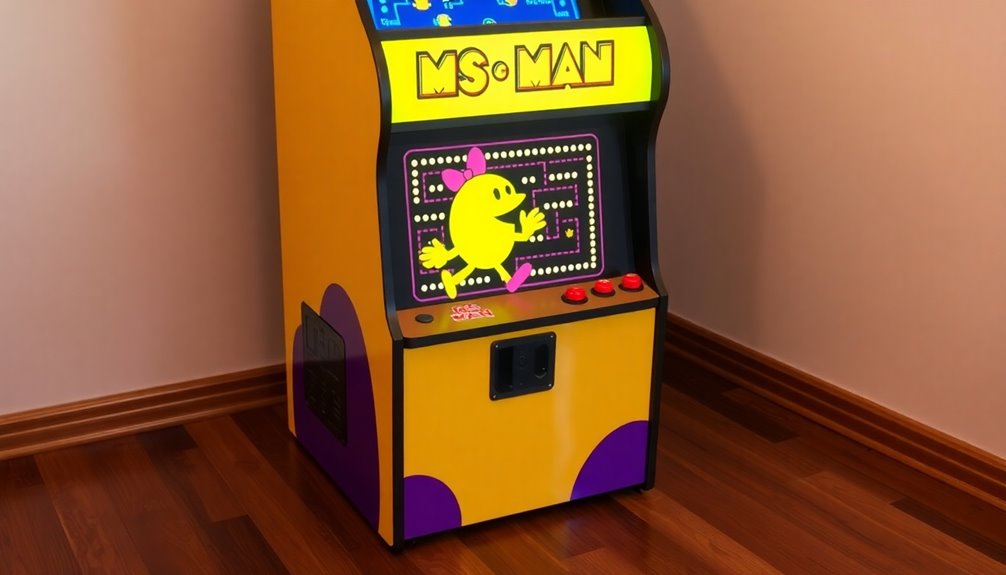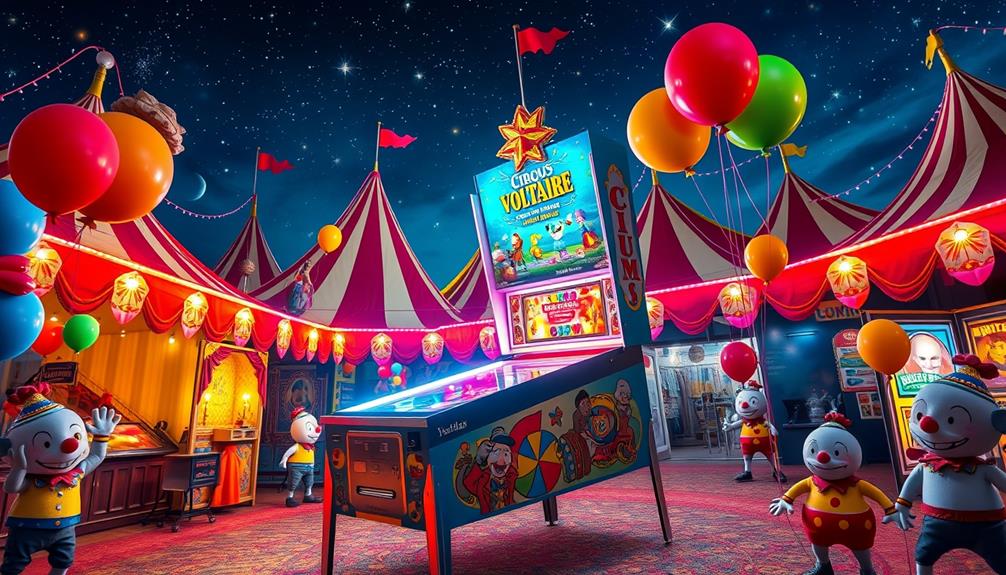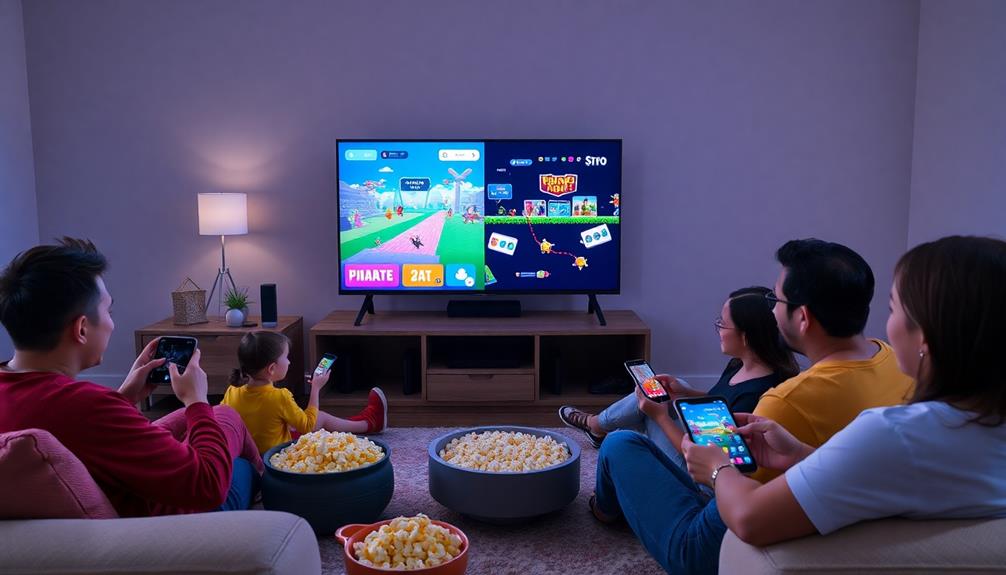Owning a Ms. Pac-Man machine means you've got a classic piece of gaming history right in your home. Released in 1982, this iconic arcade game made waves with its engaging gameplay and unique maze designs. It grossed $1.5 billion adjusted for inflation, solidifying its legacy in the gaming world. Plus, it was inducted into the World Video Game Hall of Fame in 2022. As a collectible, a restored Ms. Pac-Man cabinet can command high values, connecting you with a vibrant community of retro gaming enthusiasts. Stick around, and you might discover even more about its storied past and significance.
Key Takeaways
- Owning a Ms. Pac-Man machine offers collectors a tangible piece of gaming history, celebrating its iconic status since 1982.
- The game has a rich legacy, grossing approximately $3.5 billion by 1995, showcasing its enduring popularity.
- Ms. Pac-Man machines are highly sought-after collectibles, with vintage units varying in price based on condition and restoration.
- Community events and tournaments keep the spirit of Ms. Pac-Man alive, fostering connections among retro gaming enthusiasts.
- The game's unique maze designs and enhanced AI offer a nostalgic gameplay experience that continues to engage players.
Overview of Ms. Pac-Man
Ms. Pac-Man burst onto the gaming scene in 1982, quickly establishing herself as an iconic figure in the arcade game world. Developed by Midway Games, this sequel to the original Pac-Man introduced a female protagonist, a rarity in video games at the time. With new maze designs and enhanced AI for ghost characters, Ms. Pac-Man evolved the gameplay, offering players a fresh experience that captivated millions.
By 1987, Ms. Pac-Man had grossed around $1.2 billion and sold 125,000 arcade units by 1988, topping charts and solidifying her place in gaming history. The cultural impact of Ms. Pac-Man is undeniable, as she led the charge for more diverse representations in gaming and inspired countless adaptations and merchandise. In 2022, her legacy was honored with induction into the World Video Game Hall of Fame, highlighting her significance in the evolution of video games.
Despite ongoing legal battles regarding rights and royalties, Ms. Pac-Man remains a celebrated figure. Her influence continues to resonate, making her a key player in the narrative of video game history and a beloved character in the arcade landscape.
Gameplay Features and Mechanics
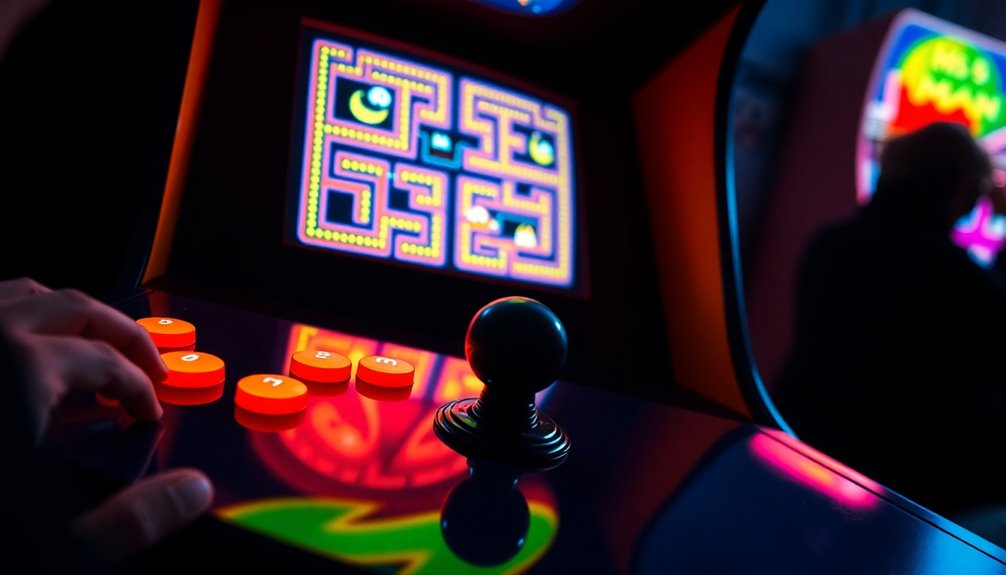
How does the gameplay of Ms. Pac-Man keep you hooked? It's all about the variety and challenge. With multiple maze designs, each round presents a fresh experience, enhancing your engagement. The improved AI of the ghost characters adds a layer of strategy, making their movements more unpredictable. You'll need to stay alert and think ahead to outsmart them.
One of the game's key mechanics involves power pellets. When you consume these, you temporarily turn the tables on the ghosts, allowing you to chase them down and rack up extra points. This strategic element keeps the gameplay dynamic and exciting.
As you navigate the maze, you'll also encounter bonus fruits that appear randomly. These fruits offer increasing point values, encouraging you to plan your movements carefully for maximum score potential. And as you progress through the rounds, the speed of gameplay ramps up. This not only affects how you maneuver but also changes the behavior of the ghost characters, creating an intense arcade game experience that tests your skills.
Ms. Pac-Man's blend of features makes every session a thrilling challenge you won't want to miss.
Development and Release Timeline
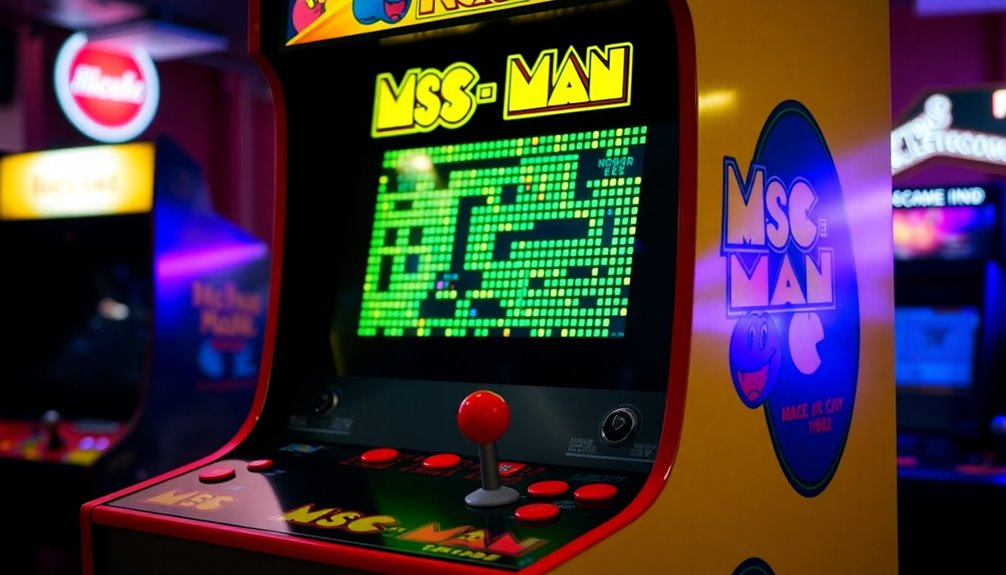
In early 1982, Ms. Pac-Man emerged from the creative minds at General Computer Corporation (GCC) as an enhancement kit initially called Crazy Otto. After a legal settlement with Atari regarding another project, GCC transformed Crazy Otto into what we now know as Ms. Pac-Man. The game made its public debut on February 3, 1982, at Castle Park Entertainment Center, captivating players right away.
The development team focused on improving gameplay mechanics and introducing new maze designs, which significantly enhanced the experience compared to the original Pac-Man. This innovation played a crucial role in its commercial success, as it quickly gained popularity across arcade cabinets nationwide. By 1988, Ms. Pac-Man had sold around 125,000 arcade units, solidifying its status as one of the highest-grossing arcade games in history. Remarkably, the game grossed $1.2 billion by 1987 and reached $1.5 billion by 1995, with adjusted estimates suggesting total revenue around $3.5 billion.
Ms. Pac-Man isn't just a game; it's a milestone in gaming history that continues to resonate with fans today.
Legal Battles and Royalties

Despite its massive success and cultural impact, Ms. Pac-Man has faced significant legal problems over the years. Originally, General Computer Corporation (GCC) retained rights to Ms. Pac-Man but found itself embroiled in disputes with Namco regarding royalty payments. GCC argued that it deserved royalties for electronic transmissions, while Namco maintained that such payments applied only to coin-operated machines. This disagreement led to a lengthy arbitration process lasting nearly four years.
In 1983, an agreement allowed GCC to keep royalties from coin-operated machines, but by around 1987, the rights for Ms. Pac-Man transferred entirely to Namco. Fast forward to more recent years, and AtGames acquired rights to collect royalty payments related to Ms. Pac-Man. However, they too faced a lawsuit from Bandai Namco over licensing agreements, culminating in a settlement in 2020.
These ongoing legal battles have complicated Ms. Pac-Man's presence in new game releases, exemplified by her exclusion from the Pac-Man Museum Plus. The intricacies of copyright and trademark issues continue to shape the legacy of this iconic game character, impacting her availability and representation in the gaming world.
Reception and Popularity
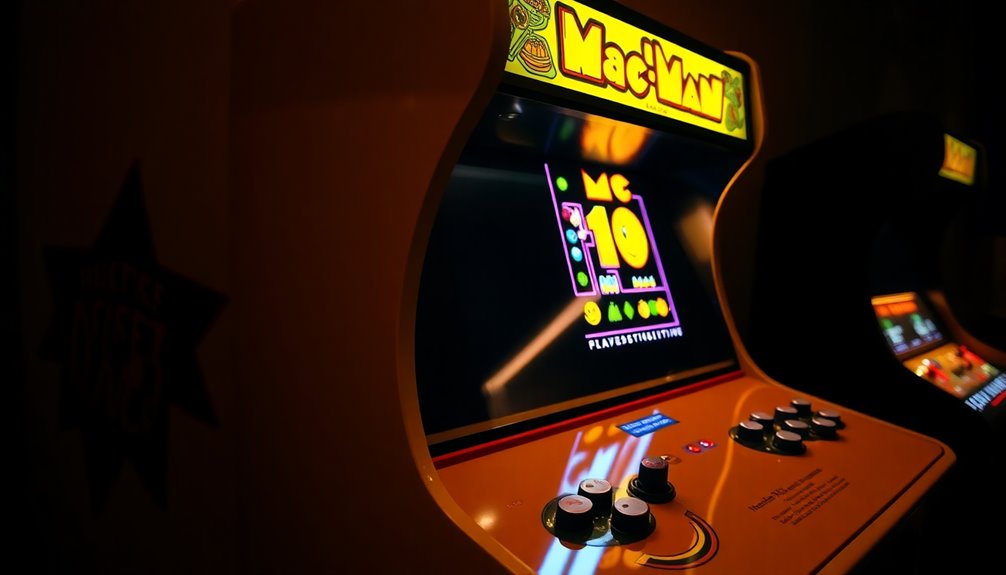
Ms. Pac-Man isn't just a game; it's a phenomenon that took the arcade scene by storm. Topping the RePlay upright cabinet charts throughout 1982, its popularity among arcade enthusiasts was undeniable. The game held the number one spot on the US RePlay cocktail cabinet charts for an impressive 23 consecutive months, proving its lasting appeal.
By 1987, Ms. Pac-Man had grossed a staggering $1.2 billion in revenue, and that figure skyrocketed to $1.5 billion when adjusted for inflation by 1995. These numbers solidify its status as one of the best-selling arcade games of its time, with 125,000 arcade cabinets sold by 1988. This remarkable success not only highlights Ms. Pac-Man's financial achievement but also cements its legacy in gaming history.
The game's cultural impact endures, as it consistently appears in retrospectives and rankings of the greatest video games of all time. Whether you played it back in the day or are discovering it for the first time, Ms. Pac-Man remains a beloved classic that continues to resonate with gamers of all ages.
Game Adaptations and Versions
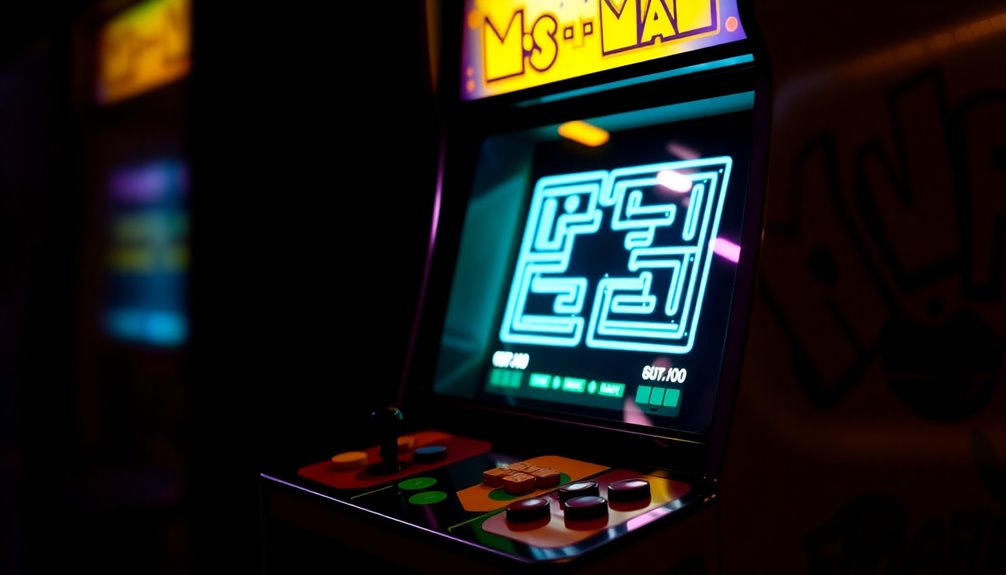
The phenomenal success of Ms. Pac-Man sparked a wave of game adaptations and versions that kept the game alive across various platforms. Since its debut on February 3, 1982, at Castle Park Entertainment Center, Ms. Pac-Man has transcended its original arcade game roots. You can find a variety of home versions released by Atari, Inc., including special 20th and 25th Anniversary Editions. These adaptations showcase the game's versatility and enduring charm.
Moreover, Ms. Pac-Man has been ported to modern gaming systems like the NES, Atari Lynx, PlayStation, Xbox 360, and even PS4/Xbox One/Windows. This adaptability ensures that you can enjoy the classic maze-chase gameplay, no matter your preferred platform.
New arcade machines featuring Ms. Pac-Man continue to be re-released, highlighting the game's lasting appeal in arcades. If you want to relive the nostalgia, Jakks Pacific even produced a standalone battery-powered version that connects to your TV. This ongoing interest from consumers proves that Ms. Pac-Man remains a beloved video game, captivating both new players and longtime fans alike.
Cultural Significance and Impact
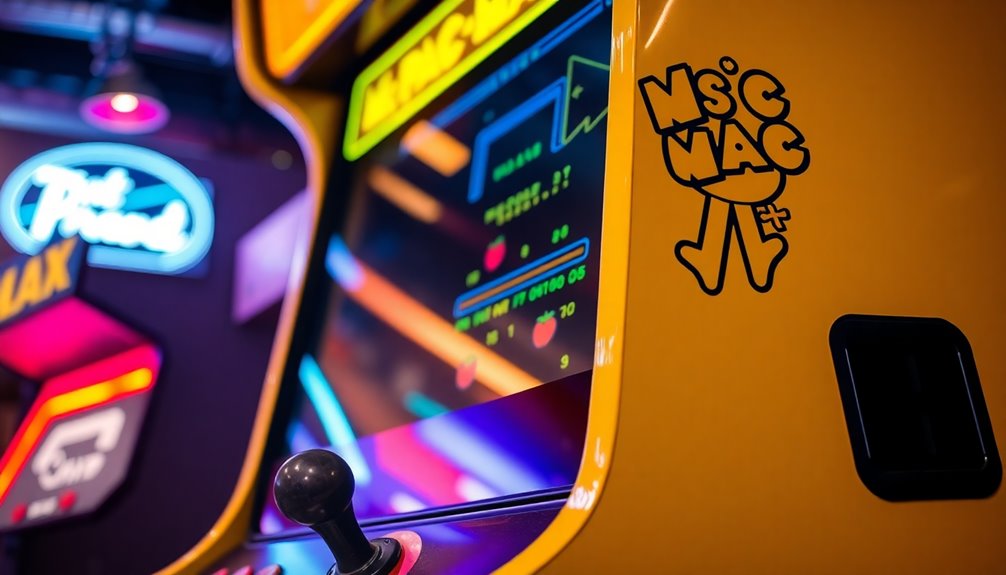
Emerging as a cultural icon, Ms. Pac-Man transformed the gaming landscape when it was released in 1982. As one of the highest-grossing arcade games of its time, it grossed an impressive $1.2 billion by 1987 and sold 125,000 units by 1988. The game's innovative mechanics, such as multiple maze designs and enhanced AI, not only captivated players but also set a new standard for future video games.
More than just an entertaining pastime, Ms. Pac-Man played a crucial role in promoting female representation in gaming. She stands as one of the first female characters to take center stage in video games, paving the way for more diverse protagonists. Her cultural impact is undeniable, with her inclusion in discussions about the greatest video games of all time and her induction into the World Video Game Hall of Fame in 2022.
Today, Ms. Pac-Man continues to resonate, appearing in various media and merchandise, further solidifying her legacy in arcade culture. By owning a Ms. Pac-Man machine, you're not just acquiring a game; you're embracing a vital piece of gaming history that celebrates both innovation and representation.
Nostalgia and Community Engagement

Nostalgia for Ms. Pac-Man runs deep in the hearts of gamers. Celebrating its 40th anniversary in 2022, community events brought players together, showcasing the game's lasting impact on gaming culture. Whether you remember playing in arcades or discovering it later, Ms. Pac-Man has shaped many gaming journeys, sparking countless conversations on social media and forums where fans share their experiences and memories.
This nostalgia has also led to an array of merchandise, like collectible arcade cabinets, allowing you to own a piece of this classic legacy. You'll find that community-driven initiatives, such as tournaments and retro gaming nights, cultivate connections among players, highlighting the shared love for Ms. Pac-Man. These events not only celebrate the game but also foster a sense of belonging within the gaming community.
As modern adaptations continue to reference Ms. Pac-Man, the character remains relevant and cherished among both old and new generations of gamers. Embracing this nostalgia, you can engage with fellow fans, reliving those thrilling moments and creating new memories that keep the spirit of Ms. Pac-Man alive.
Collecting Ms. Pac-Man Machines

If you've ever dreamed of owning a piece of gaming history, collecting Ms. Pac-Man machines is an exciting opportunity. Originally released in 1982, this iconic arcade game sold around 125,000 units by 1988, making it a sought-after collectible. By adding a Ms. Pac-Man machine to your collection, you'll celebrate the game's 40th anniversary and its lasting legacy in arcade gaming.
Vintage arcade cabinets can vary widely in price, with fully restored units often commanding high market values. This reflects their nostalgic significance and the demand among retro gaming fans. Many collectors appreciate Ms. Pac-Man's unique design and gameplay features, which introduced new maze layouts and improved AI—setting it apart from its predecessor.
Collecting Ms. Pac-Man machines not only lets you own a slice of gaming history, but also connects you with a vibrant community of enthusiasts. The ongoing presence of Ms. Pac-Man in merchandise and community events highlights her enduring appeal. So, whether you're a long-time fan or new to arcade collecting, owning a Ms. Pac-Man machine allows you to engage deeply with gaming culture while indulging your love for nostalgia.
Future of Ms. Pac-Man

The future of Ms. Pac-Man remains uncertain, primarily due to ongoing legal disputes that have sidelined her from recent game releases, including the upcoming Pac-Man Museum Plus. This exclusion is particularly disappointing for fans who've long enjoyed her character's charm. AtGames, which has secured rights to collect royalties related to Ms. Pac-Man, finds itself entangled in legal challenges from Bandai Namco, complicating not just digital releases but also the availability of Ms. Pac-Man merchandise.
While alternative characters like Pac-Mom have emerged in newer titles, this shift reflects a strategic move to avoid the royalty implications tied to Ms. Pac-Man's legacy. As negotiations continue and disputes linger, her presence in the gaming market hangs in the balance.
The potential for new Ms. Pac-Man projects is contingent upon resolving these legal conflicts. Until clear agreements are established, her future in both gaming and merchandise remains tenuous. You might want to stay tuned, as the outcome could redefine Ms. Pac-Man's legacy and open doors for fresh content that celebrates this iconic character.
Frequently Asked Questions
Who Owns the Ms. Pac-Man Game?
You'll find that the rights to Ms. Pac-Man are held by Bandai Namco, while General Computer Corporation retains certain royalties. Ongoing disputes complicate ownership, especially regarding licensing agreements and newer game releases.
How Did Pac-Man Revolutionized Gaming?
Pac-Man revolutionized gaming by introducing non-violent gameplay, engaging AI, and strategic power-ups. You navigate mazes, outsmart ghosts, and earn points, redefining player interaction and making video games accessible and appealing to a wider audience.
Was Pac-Man the First Video Game Character?
No, Pac-Man wasn't the first video game character. However, he's one of the most recognizable, revolutionizing character design and appealing to a broader audience, including women, and paving the way for future iconic characters.
What Is the Story Behind Ms. Pac-Man?
You'll discover that Ms. Pac-Man originated as Crazy Otto, created after disputes with Atari. Released in 1982, it featured new mazes and smarter ghosts, quickly becoming a massive success and a pioneering female video game character.
Conclusion
Owning a Ms. Pac-Man machine is more than just having a piece of gaming history; it's about embracing nostalgia and connecting with a vibrant community. This iconic game continues to captivate players of all ages, reminding us of the joy and challenge that arcade gaming brings. By adding a Ms. Pac-Man machine to your collection, you're not just investing in a classic; you're keeping the spirit of gaming alive for future generations to enjoy.
